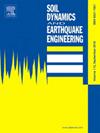Frequency domain response of the lateral vibration of offshore defective pipe piles considering pile–soil–water coupling effects
IF 4.2
2区 工程技术
Q1 ENGINEERING, GEOLOGICAL
引用次数: 0
Abstract
To investigate the lateral dynamic characteristics of defective pipe piles in offshore environments, this study develops a new framework to obtain a frequency-domain analytical solution for the lateral coupled vibration of defective pile–soil–water systems considering vertical static loading. The soil resistance inside and outside the pile calculated via Biot’s theory and the dynamic water pressure is calculated using of radiation wave theory. The pipe pile is modeled as an Euler beam, with the lateral dynamic impedance at the pile head determined using continuity conditions applied at the pile–soil and pile–water interfaces. The accuracy of the analytical solution is validated, and the study delves into the effects of pile defects, soil layers, water, and vertical loads on the lateral dynamic impedance of piles. The results indicate that external diameter necking defects and modulus reduction defects have the most significant impact on lateral dynamic impedance. Defects located in shallow soil layers at a certain depth from the water–soil interface have the greatest influence on pile head lateral dynamic stiffness (PHLDS), with longer defects having a greater impact. Reinforcing weak shallow soil layers can enhance the pile’s resistance to lateral deformation. The influence of water and vertical static loading on the pile foundation’s dynamic impedance exhibits a synergistic effect. In pile foundation design, defects in pile sections near the water–soil interface should be strictly avoided.
考虑桩-土-水耦合效应的海上缺陷管桩横向振动频域响应
为了研究海洋环境中缺陷管桩的横向动力特性,本文建立了考虑竖向静荷载的缺陷桩-土-水体系横向耦合振动的频域解析解框架。采用比奥理论计算桩内外土阻力,采用辐射波理论计算动水压力。将管桩建模为欧拉梁,采用桩-土和桩-水界面连续条件确定桩顶侧移动力阻抗。验证了解析解的准确性,探讨了桩缺陷、土层、水、竖向荷载对桩侧动力阻抗的影响。结果表明,外径颈缩缺陷和模量降低缺陷对横向动态阻抗的影响最为显著。距离水土界面一定深度的浅土层缺陷对桩头横向动刚度影响最大,缺陷长度越大,影响越大。对软弱的浅土层进行加固,可以提高桩的抗侧变形能力。水和竖向静荷载对桩基动力阻抗的影响呈协同效应。在桩基设计中,应严格避免靠近水土界面的桩段出现缺陷。
本文章由计算机程序翻译,如有差异,请以英文原文为准。
求助全文
约1分钟内获得全文
求助全文
来源期刊

Soil Dynamics and Earthquake Engineering
工程技术-地球科学综合
CiteScore
7.50
自引率
15.00%
发文量
446
审稿时长
8 months
期刊介绍:
The journal aims to encourage and enhance the role of mechanics and other disciplines as they relate to earthquake engineering by providing opportunities for the publication of the work of applied mathematicians, engineers and other applied scientists involved in solving problems closely related to the field of earthquake engineering and geotechnical earthquake engineering.
Emphasis is placed on new concepts and techniques, but case histories will also be published if they enhance the presentation and understanding of new technical concepts.
 求助内容:
求助内容: 应助结果提醒方式:
应助结果提醒方式:


